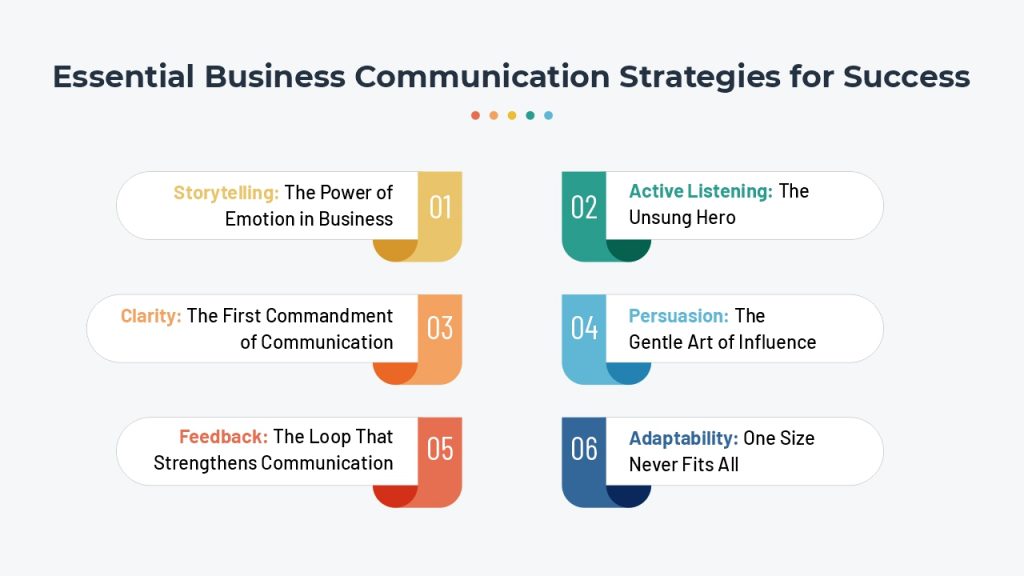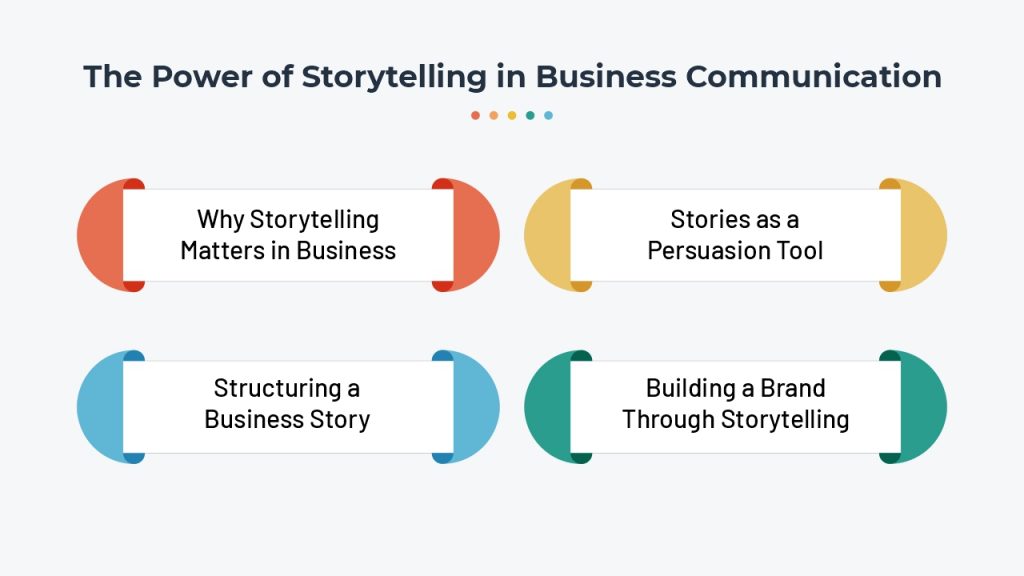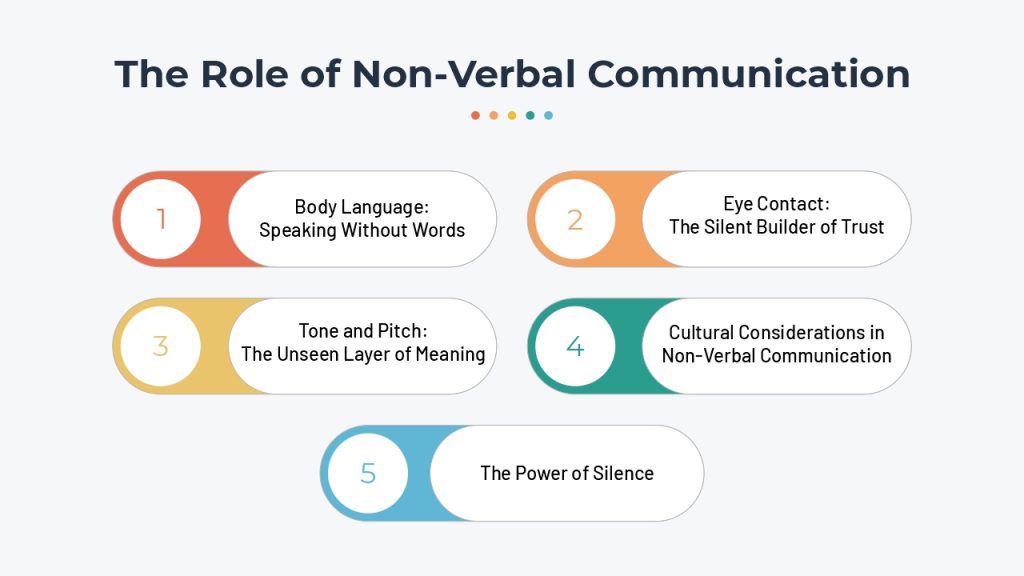Table of Contents
ToggleMastering Business Communication Skills: The Key to Professional Success

Communication is the thread that weaves businesses together, the unseen force that propels careers forward, and the silent architect of strong professional relationships. Imagine a world where ideas flow effortlessly, emails convey their intent without confusion, and meetings lead to innovation rather than frustration. That world belongs to those who master business communication skills.
In today’s dynamic corporate landscape, effective communication isn’t just about exchanging words—it’s about creating impact. Whether you’re persuading clients, motivating teams, or resolving conflicts, the way you communicate shapes how others perceive you. With the right communication strategies, even the most complex ideas can be transformed into compelling narratives that inspire action.
Yet, many professionals struggle with expressing themselves clearly, leading to misunderstandings, missed opportunities, and stagnant careers. The good news? Communication skills can be refined, perfected, and wielded like a powerful tool. This article delves into the nuances of business communication skills, exploring strategies to enhance clarity, connection, and confidence in professional interactions.
Understanding Business Communication Skills
Business communication skills encompass the ability to convey information clearly, persuasively, and professionally in a corporate setting. These skills include verbal, non-verbal, and written communication, ensuring smooth collaboration and decision-making.
Words carry weight, but so does the way they’re delivered. A confident tone, steady eye contact, and open body language can reinforce your message, while hesitation or crossed arms may unintentionally signal doubt. Communication isn’t just about speaking—it’s also about listening. Active listening involves fully engaging with the speaker, acknowledging their points, and responding thoughtfully. This fosters stronger relationships and minimizes misunderstandings.
Essential Business Communication Strategies for Success
Communication is the bridge between ideas and action, the golden thread that weaves businesses together. Yet, not all conversations spark understanding, and not every message finds its mark. In the corporate world, mastering business communication skills is not just a necessity—it’s an art. The right communication strategies can transform confusion into clarity, hesitation into confidence, and misalignment into synergy.

Clarity: The First Commandment of Communication
A message unclear is a message unheard. Whether speaking, writing, or presenting, clarity should be at the heart of all professional interactions. This means using simple language, structuring thoughts logically, and ensuring that the message resonates with the audience. Business leaders and professionals who communicate with precision are seen as trustworthy and competent.
Active Listening: The Unsung Hero
Communication is a two-way street, yet so many focus on speaking and neglect the art of listening. Active listening involves not just hearing words but understanding intent, emotions, and nuances. A well-timed pause, a thoughtful nod, or a follow-up question can make all the difference in fostering meaningful interactions.
Adaptability: One Size Never Fits All
Not all audiences are the same, nor are all communication mediums. A CEO’s boardroom presentation demands a different tone than a casual team email. Successful professionals tailor their business communication skills to the audience, the platform, and the purpose, ensuring messages are received as intended.
Storytelling: The Power of Emotion in Business
Facts inform, but stories inspire. Whether selling a product, leading a team, or presenting an idea, weaving narratives into professional conversations makes communication more engaging and memorable. The best communicators don’t just state—they narrate, pulling listeners into the world of their message.
Persuasion: The Gentle Art of Influence
In business, persuasion is not about manipulation—it’s about alignment. The best communication strategies help bridge perspectives, build consensus, and inspire action. Using logic, emotion, and credibility, professionals can turn objections into opportunities and hesitations into commitments.
Feedback: The Loop That Strengthens Communication
No message exists in a vacuum. Seeking, giving, and refining feedback ensures that communication remains effective. Encouraging an open feedback culture fosters growth, minimizes misunderstandings, and sharpens business communication skills over time.
Success in the business world is often measured not just by ideas but by how well they are communicated. Mastering essential communication strategies ensures that messages don’t just land but resonate. Whether through clarity, storytelling, or persuasion, the art of communication remains the key to influence, leadership, and success.
Types of Business Communication
In the corporate world, communication is the glue that holds everything together. Without it, businesses falter, projects stall, and misunderstandings thrive. Mastering business communication skills isn’t just about speaking or writing well—it’s about using the right communication strategies for the right situation. Understanding the different types of business communication is the first step toward clarity and efficiency.
1. Verbal Communication: The Spoken Word
From boardroom meetings to casual hallway conversations, verbal communication is the foundation of business interaction. Tone, pace, and articulation all play a crucial role in conveying meaning. A confident speaker can inspire a team, while a poorly communicated message can create confusion.
2. Written Communication: The Power of Words on Paper
Emails, reports, memos, and contracts—all require strong written communication. Unlike spoken words, written messages are permanent records of information. Clarity, conciseness, and a professional tone ensure that the intended message is understood without ambiguity.
3. Non-Verbal Communication: The Unspoken Language
Gestures, facial expressions, and posture often speak louder than words. A firm handshake can convey confidence, while crossed arms may signal resistance. Understanding non-verbal cues is essential for interpreting hidden emotions and fostering better workplace interactions.
4. Visual Communication: A Picture Speaks a Thousand Words
Infographics, charts, and presentations help simplify complex information. A well-designed visual can enhance understanding and retention, making it a valuable tool for professionals looking to improve their business communication skills.
5. Formal vs. Informal Communication
Corporate emails and official reports require a structured, professional tone, while a casual team chat may allow for more relaxed language. Understanding the balance between formal and informal communication is key to ensuring messages are appropriately received.
Mastering different types of business communication ensures that professionals can adapt to any situation, whether through speech, writing, or visual representation. Strong communication strategies not only prevent misunderstandings but also build trust, strengthen relationships, and drive business success.
The Power of Storytelling in Business Communication
Facts inform, but stories inspire. In business, data alone isn’t enough to persuade or motivate; storytelling transforms cold information into engaging narratives that resonate. Whether selling an idea, leading a team, or building a brand, the ability to tell a compelling story is a vital business communication skill.

1. Why Storytelling Matters in Business
Numbers fade, but emotions linger. A well-told story connects with people on a personal level, making information easier to absorb and remember. Companies that harness storytelling create deeper relationships with their customers, employees, and stakeholders.
2. Stories as a Persuasion Tool
A compelling story has the power to influence decision-making. Instead of presenting dry facts, professionals can use storytelling to craft relatable scenarios that engage and convince their audience.
3. Structuring a Business Story
Every great story follows a structure:
- The Challenge: What problem needed solving?
- The Journey: What actions were taken?
- The Resolution: What was the outcome?
By framing messages this way, businesses can make even the most technical details compelling and memorable.
4. Building a Brand Through Storytelling
The most successful brands tell stories, not just sell products. Companies like Apple and Nike don’t just talk about their offerings—they share stories of innovation, perseverance, and vision. Strong storytelling differentiates businesses in competitive markets.
Mastering storytelling as part of business communication skills elevates a professional’s ability to connect, persuade, and inspire. By using this communication strategy, businesses can turn ordinary messages into extraordinary ones, making an impact that lasts.
Improving Written Communication in Business
In business, words wield power. A single email can close a deal or cause confusion. A well-crafted proposal can inspire action, while a poorly written report can stall progress. Strong business communication skills are essential for effective writing, ensuring messages are clear, professional, and purposeful.
1. Clarity and Simplicity: Less is More
Good business writing gets to the point. Complex words and jargon dilute meaning. Short sentences, active voice, and precise language make written communication stronger and more effective.
2. The Right Tone for the Right Audience
A message to a senior executive differs from an email to a colleague. Understanding the audience ensures that tone and language are appropriate. A warm but professional tone fosters collaboration, while a too-casual approach may come across as unprofessional.
3. Structure for Readability
Nobody enjoys reading long, unstructured emails. Breaking text into sections with headings, bullet points, and concise paragraphs makes messages easier to digest.
4. Proofreading: The Final Step
Even the best writers make mistakes. Proofreading eliminates typos and grammatical errors that can damage credibility. Reading messages aloud or using tools like Grammarly can help refine communication.
Mastering written communication is an essential business communication skill. By applying the right communication strategies, professionals can craft messages that are clear, persuasive, and effective, ensuring their words always leave the intended impact.
The Role of Non-Verbal Communication
They say actions speak louder than words, and in the world of business, this couldn’t be truer. While words carry intent, non-verbal cues carry conviction. A firm handshake, an engaging smile, or a well-timed pause can be just as powerful as a well-crafted speech.

1. Body Language: Speaking Without Words
Posture, gestures, and facial expressions often communicate more than spoken words. A confident stance exudes leadership, while crossed arms may signal defensiveness. Being mindful of body language enhances credibility and influence.
2. Eye Contact: The Silent Builder of Trust
Too little eye contact may suggest insecurity, while too much can feel intrusive. Striking a balance fosters connection and demonstrates sincerity.
3. Tone and Pitch: The Unseen Layer of Meaning
The way words are spoken shapes how they are received. A warm, enthusiastic tone can uplift, while a flat, monotonous voice can dull even the most exciting message.
4. The Power of Silence
Silence is not empty—it is full of meaning. Strategic pauses can emphasize key points, invite reflection, or signal authority.
5. Cultural Considerations in Non-Verbal Communication
Gestures and expressions vary across cultures. A thumbs-up may signify approval in one country but be offensive in another. Professionals navigating international business must be aware of cultural nuances to avoid misinterpretation.
Non-verbal cues are the unspoken language of communication. By refining body language, tone, and gestures, professionals can amplify their business communication skills, ensuring messages are not just heard but felt.
Overcoming Common Communication Barriers
Despite our best efforts, communication is often hindered by obstacles—some visible, others hidden in plain sight. These barriers can distort messages, breed misunderstandings, and hinder collaboration. But with the right communication strategies, they can be dismantled.
1. Language Barriers: The Challenge of Clarity
Overly complex language, jargon, or technical terms can alienate listeners. Using simple, accessible words ensures that messages are clear to all, regardless of background or expertise.
2. Emotional Barriers: The Silent Disruptors
Stress, frustration, or preconceived notions can cloud how messages are received. Emotional intelligence—acknowledging emotions without letting them dictate responses—is key to effective communication.
3. Technological Barriers: When Tools Become Obstacles
Emails, virtual meetings, and instant messages are convenient but can also lead to miscommunication. Poorly worded emails can create confusion, while virtual meetings without proper etiquette may dilute the impact of discussions. The best business communication skills ensure technology serves as a bridge, not a barrier.
4. Cultural Differences: A World of Perspectives
What is considered polite in one culture may be offensive in another. Awareness of cultural norms enhances global communication and prevents unintended misunderstandings.
5. Assumptions and Misinterpretations: The Root of Confusion
Assuming intent without clarification often leads to errors. Asking clarifying questions, summarizing key points, and encouraging open dialogue prevent misunderstandings.
Communication barriers are not roadblocks—they are challenges waiting to be overcome. By refining communication strategies, professionals can ensure their messages are not just delivered but truly understood. In the end, successful communication is not just about speaking—it’s about connecting.
The Future of Business Communication
The world of business communication is evolving rapidly. With technology, remote work, and digital advancements changing how we interact, professionals must continuously refine their business communication skills to stay relevant.
1. The Digital Shift: Virtual First Communication
Emails, video calls, and instant messaging are replacing traditional face-to-face meetings. As remote work grows, professionals must learn to communicate effectively in digital spaces, ensuring clarity and engagement even without in-person interaction.
2. AI and Automation in Communication
AI-powered tools are reshaping communication. From chatbots handling customer service to AI-generated reports, automation is streamlining business interactions. However, human oversight remains crucial to maintaining authenticity and trust.
3. The Importance of Emotional Intelligence
Technology may enhance communication, but emotional intelligence remains irreplaceable. Understanding tone, context, and non-verbal cues ensures that messages are not just delivered but truly understood.
4. Ethics and Transparency in Business Communication
With increased digital communication comes the responsibility of maintaining ethical and transparent practices. Misinformation, privacy concerns, and corporate accountability are now central to business discussions.
The future of business communication is digital, fast-paced, and ever-changing. However, at its core, it remains about connection. By adapting communication strategies to new technologies while preserving human authenticity, businesses can thrive in the evolving landscape.
FAQs
Conclusion
Mastering business communication skills isn’t just a career asset—it’s a necessity. Effective communication builds credibility, fosters collaboration, and drives success. Whether through words spoken, written, or unspoken gestures, each interaction shapes professional relationships and opportunities. By refining communication strategies, professionals can navigate challenges with confidence, turning every conversation into a stepping stone toward success.

